Passing Your State’s Emissions Inspection Just Got Easier Thanks to FIXD Emissions Precheck
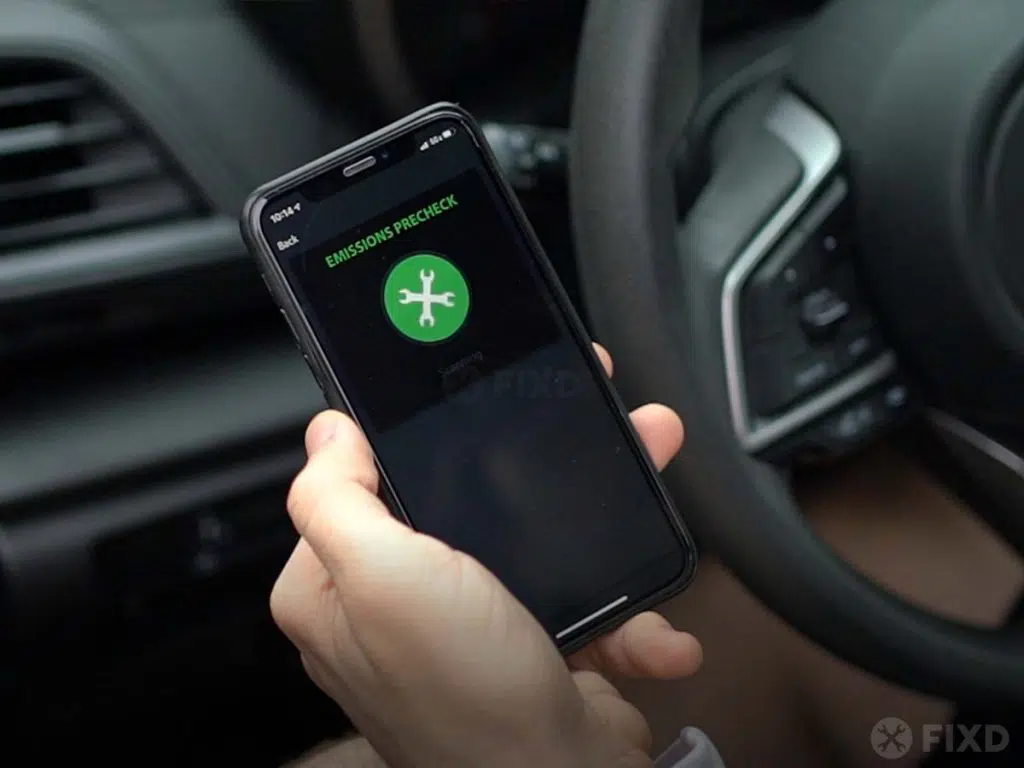
If you live in a state that requires emissions testing, you’re all too familiar with sitting in line at a crowded facility, crossing your fingers and hoping you pass the first time. The last thing you want to deal with is the hassle of failing an inspection with a vehicle that’s illegal to drive.
That’s why we created the FIXD Emissions Precheck. FIXD Premium users have access to this handy feature that tells you in advance if you’ll pass emissions, or what to do if you won’t, so that you can avoid wasted time and testing fees.
Here’s everything you need to know about this feature, including how to perform an Emissions Precheck on your car, what conditions are checked through the FIXD Sensor and app, what to do if you get a “not ready” message, and more.
What Is an Emissions Test?
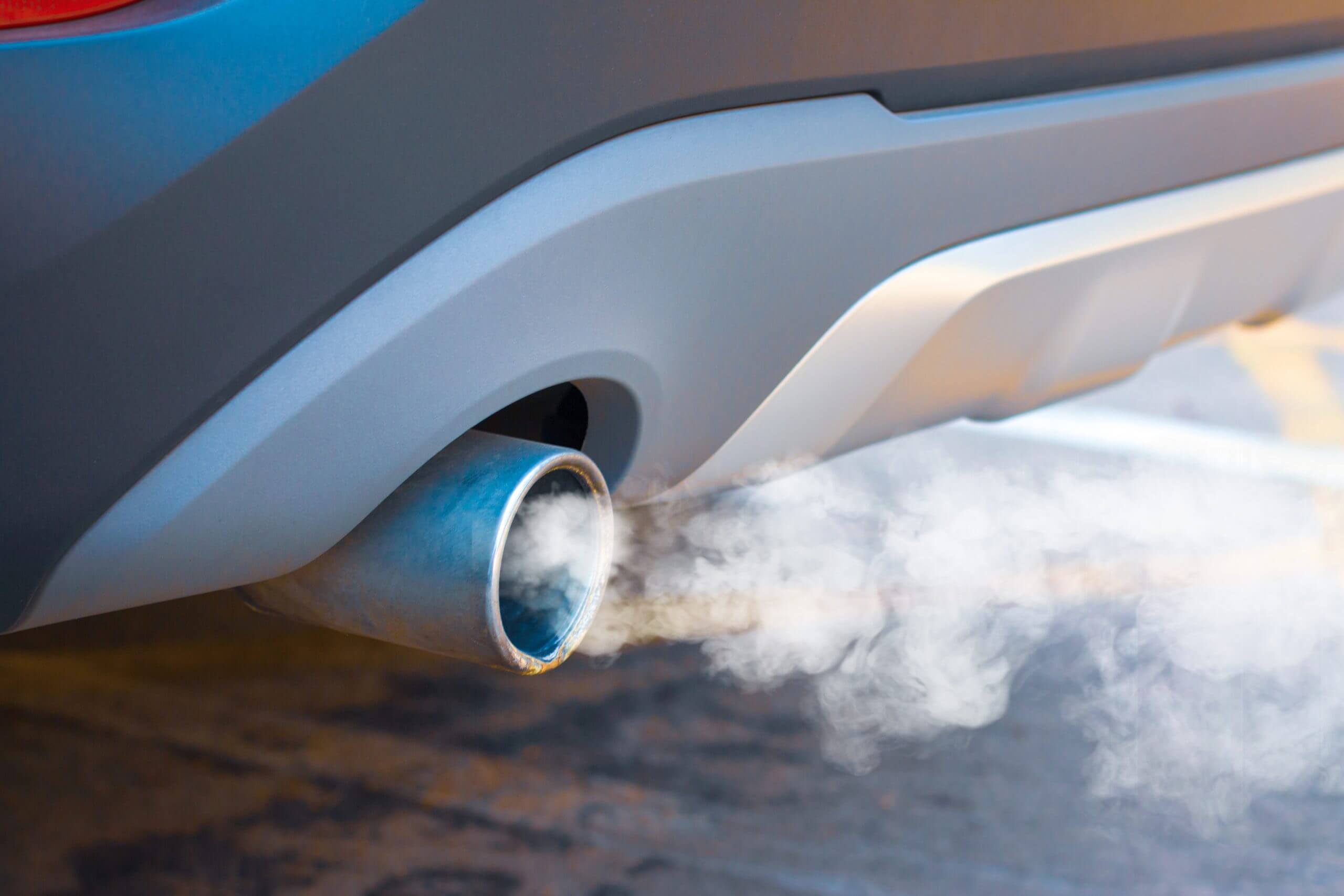
An emissions test, or “smog check,” measures the amount of harmful pollutants, including hydrocarbons, oxygen, carbon monoxide, and oxides of nitrogen present in your vehicle’s exhaust. These tests are usually performed when registering your car, truck, or SUV or during annual safety inspections. If required by your state, you must pass emissions testing in order for it to be considered legal to drive.
FIXD Emissions Pre-check runs the same tests as official emissions inspections so that car owners can quickly and easily see if they’ll pass.
Why Is Emissions Testing Important?
Cars were first linked to air pollution in the 1950s when a California researcher found heavy traffic to be the cause of the smog over Los Angeles. Since that time, the U.S. Environmental Protection Agency (EPA) has set standards to reduce emissions of harmful pollutants from our cars.
In 1990, the Federal Clean Air Act was amended to reduce air pollution even more, and the EPA set a new standard for vehicle emissions. Routine emissions testing ensures that vehicles on the road meet these standards and helps us all do our part to keep the air clean.
In addition to the environmental impact emissions testing, these inspections are also important to keep your car running smoothly and efficiently. Just as tires and brakes require maintenance, your emissions system suffers wear and tear from driving, too. This inspection helps make sure that your emissions system is operating properly and free of check engine errors that could turn into costly repairs.
Am I Required to Get an Emissions Test?
There are currently 33 states in the U.S. that require emissions testing. However, this list is constantly changing, so be sure to check with your state’s environmental agency for accurate information that is up to date.
In some cases, new vehicles as well as electric vehicles are exempt from inspections.
How Does Emissions Testing Work?
When you arrive at your local approved emissions testing facility, a technician will connect a diagnostic device to your vehicle’s OBD2 port. Every car made since 1996 is required to have an Onboard Diagnostics (OBD2) system that is responsible for monitoring engine performance and emissions. (If your car was made before 1996, the technician will use a probe to read emissions directly in the tailpipe.)
Using their OBD2 scan tool, the technician will complete a series of tests on OBD2 monitors as well as check for any stored check engine codes. There are only 2 outcomes to an emissions test: pass or fail. Having a check engine light on or unsuccessfully completing the OBD2 system monitors that are built into the vehicle will result in a failed test and time and money wasted.
Now that you know what an emissions test is, find out how to do it yourself at home using FIXD Emissions Precheck so you can be confident you’ll pass on the first try!
FIXD Emissions Precheck: What It Is and How to Use It
FIXD Emissions Precheck is an exclusive feature included with a FIXD Premium membership. This tool allows users to test their car’s emissions readiness at home with the touch of a button, running the same tests as official inspections so you can be confident you’ll pass the first time.
FIXD OBD2 Monitors
The follow monitors are checked for readiness with FIXD Emissions Precheck:
Trouble Codes
In this test, we check to see if your vehicle has any active trouble codes outside of the check engine light that may cause you to fail the emissions readiness test.
Check Engine Light
In this test, we check to see if your vehicle has an active check engine light that may cause you to fail the emissions readiness test.
Sufficient Mileage
In order to be ready for an emissions test, your car has to have recorded that it has traveled a certain amount of miles since the last time a code was cleared. In this test, we check to see if that mileage is above the threshold required by your vehicle.
Components
In this test, we check for several components around the vehicle to make sure that they are working well together.
Fuel System
In this test, we check various components of your vehicle’s fuel system to make sure it is operating properly and it is not producing excessive emissions.
Misfire
In this test, we check several sensors around the vehicle for misfire conditions in the combustion process.
EGR
In this test, we check the functionality and performance of your vehicle’s Exhaust Gas Recirculation (EGR) system. The EGR system takes exhaust gases that may contain harmful pollutants and puts them back into the combustion cycle to neutralize those pollutants and prevent them from entering the atmosphere.
Oxygen Sensor Heater
In this test, we check the functionality and performance of your vehicle’s Oxygen (O2) Sensor Heater. The O2 Sensor is important in determining how much fuel gets put into the combustion cycle, but it only works when it reaches its operating temperature. To speed up the time it takes to reach its operating temperature, most O2 Sensors contain a heating element that gets it to the operating temperature very quickly.
Oxygen Sensor
In this test, we check the functionality and performance of your vehicle’s Oxygen (O2) Sensors. The O2 Sensor is important in determining how much fuel gets put into the combustion cycle. If this system is not working properly, you may be putting too much or too little oxygen into the combustion cycle and creating harmful pollutants.
A/C Refrigerant
In this test, we check to ensure that your car is not improperly discharging Air Conditioning Refrigerant.
Secondary Air System
The Secondary Air System, is an emissions related system and in this test, we check to ensure that the system is working properly to mitigate the amount of pollutants being produced by your vehicle.
EVAP System
The EVAP System is used to prevent any fuel vapors from getting into the atmosphere. In this test, we check to ensure that the system is working properly to avoid the release of these fuel vapors into the air.
Heated Catalyst
Catalysts are used to treat the exhaust gases to get rid of dangerous pollutants, but in order to work properly they must be at the correct temperature. In this test, we check to ensure that Catalysts are heating up at the proper rate to neutralize any harmful emissions.
Catalyst
Catalysts are used to treat the exhaust gases to get rid of dangerous pollutants. In this test, we check to ensure that Catalysts are properly reacting with the exhaust gases to neutralize any harmful emissions.
Compression
In this test, we check the functionality and performance of your vehicle’s Exhaust Gas Recirculation (EGR) and Variable Valve Timing (VVT) systems. The EGR system takes exhaust gases that may contain harmful pollutants and puts them back into the combustion cycle to neutralize those pollutants and prevent them from entering the atmosphere. This system works with the VVT system to make sure the combustion process is happening efficiently.
PM Filter
In this test, we check your vehicle’s Particulate Matter (PM) Filter Monitoring System. Usually found in Diesel vehicles, this system monitors the performance of the Diesel Particulate Filter (DPF) to ensure that harmful pollutants are not released into the atmosphere.
Exhaust Gas Sensor
In this test, we check your vehicle’s Exhaust Gas Sensor to ensure that it is measuring the contents of the exhaust stream properly.
Boost Pressure
If your vehicle has a turbo or supercharger, the Boost Pressure test checks to see if the vehicle is making the correct amount of intake pressure for a given engine load.
Nox/SCR Monitor
NOx (oxides of nitrogen) are harmful pollutants. In this test we monitor for the performance of your Selective Catalytic Reduction (SCR) system that is used to mitigate NOx emissions.
NMHC Catalyst
Nonmethane Hydrocarbons (NMHC) are a type of harmful emissions. In this test, we check to see the effectiveness of the catalyst that is used to eliminate these NMHCs.
How to Perform FIXD Emissions Precheck
- Step 1: Plug the FIXD Sensor into your vehicle’s OBD2 port and start the engine. Make sure Bluetooth is turned on on your smartphone and the selected vehicle in the app is the one you’re connected to.
- Step 2: From the home screen of the FIXD app on your smartphone, select Emissions Precheck.
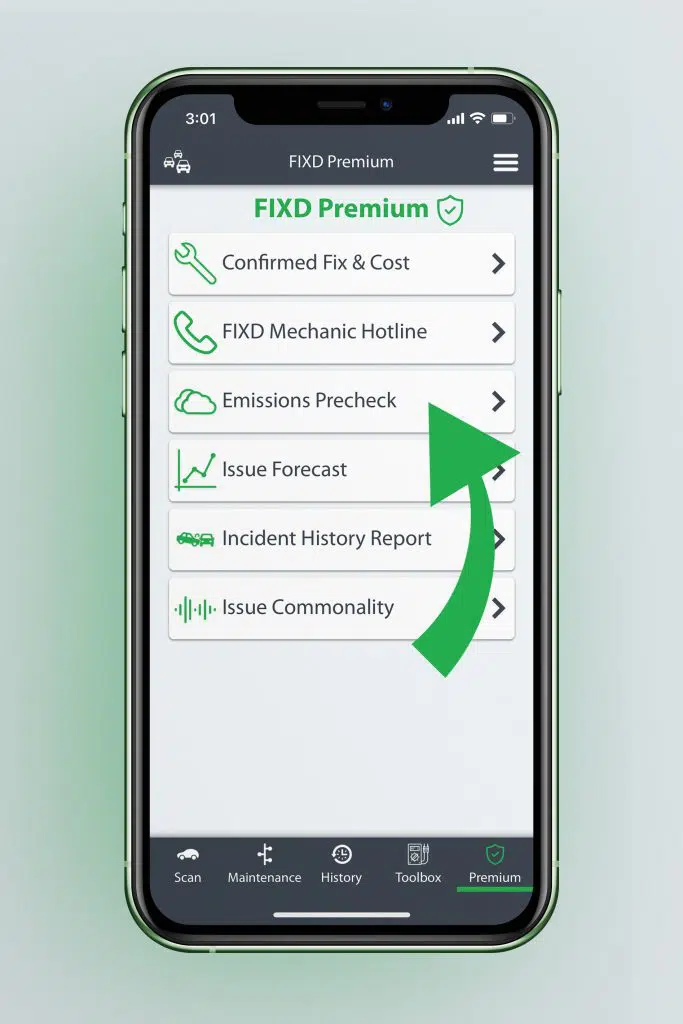
- Step 3: Tap to precheck your emissions readiness. If all systems are ready, you should receive a success message and pass emissions.
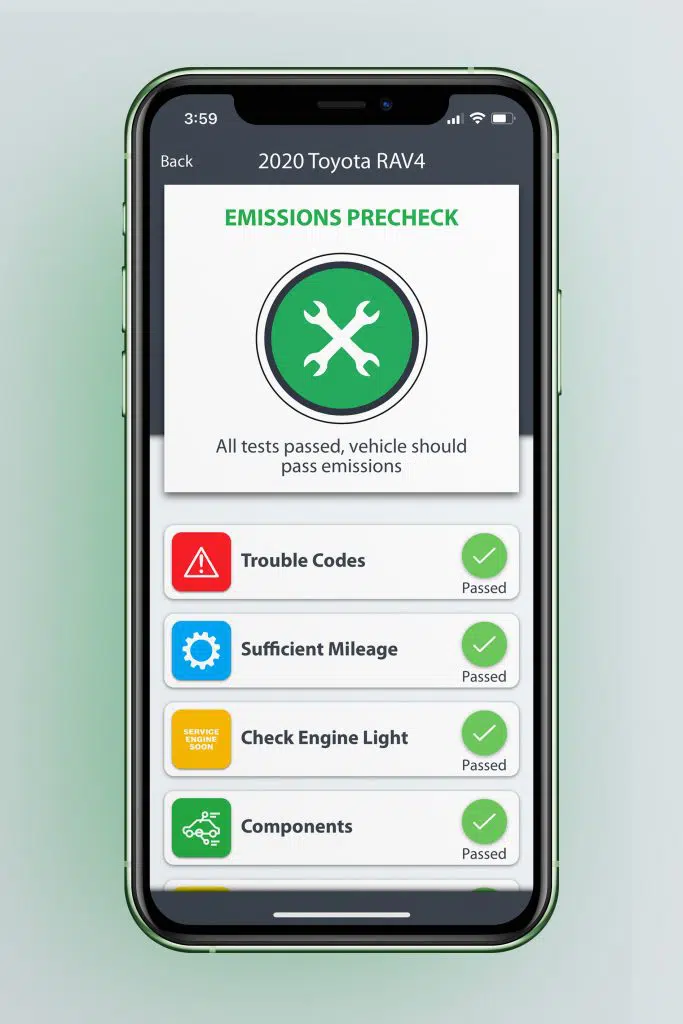
What Do I Do if FIXD Says I’m “Not Ready”?
If you receive the message “Not Ready”, this means that one or more of your vehicle’s monitors could not be completed during testing, as shown in the screenshot below:
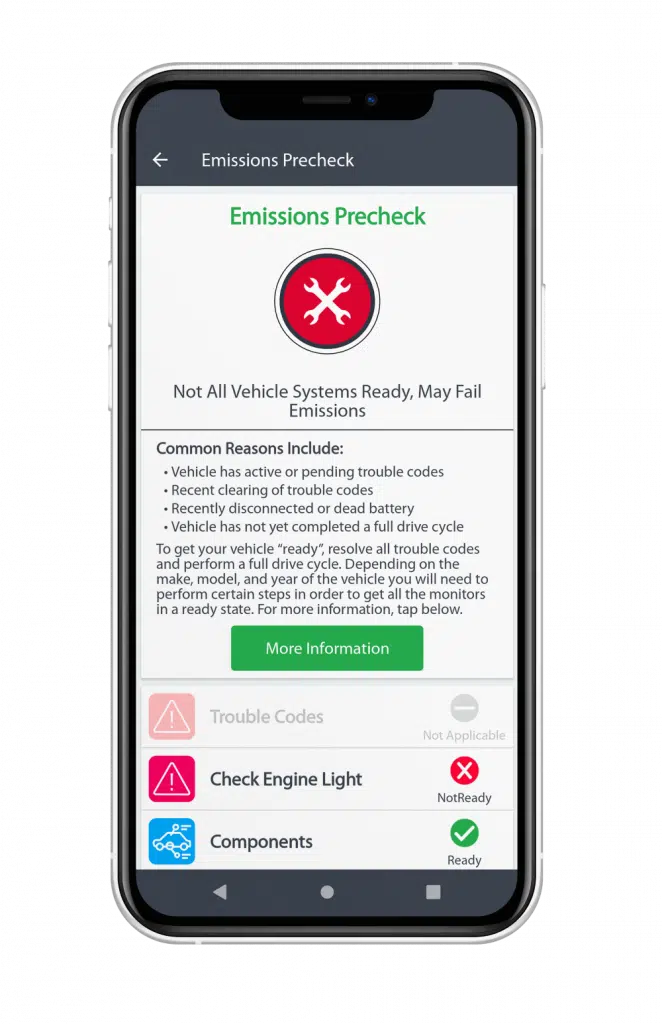
Take note of which monitors are “not ready” so you know what to fix. If a check engine light is illuminated or trouble code is detected, scan your vehicle with FIXD to learn more about this issue and how to resolve it.
Once you believe you have resolved the issue, you’ll need to complete a drive cycle before running Emissions Precheck again.
What Is a Drive Cycle?
If you received a “not ready” message and made repairs to the emissions system or reset the check engine light, you’ll want to do a drive cycle to determine whether or not those repairs were successful. A drive cycle is utilized by your vehicle’s powertrain control module (pcm) and involves a special test drive to imitate the conditions of a short trip, such as going to work. During the drive cycle, your car’s computer will run a series of tests to determine if the emissions system is working properly.
How to Perform a Drive Cycle:
Step 1: Prepare your vehicle ahead of time.
- Your gas tank should be at least 30% full in order for the tests to be accurate. If you don’t have enough fuel in the tank, some of the tests cannot be run.
- Make sure your alternator and battery are good.
- Your vehicle should sit overnight or for at least 8 hours in a moderate environment that’s less than 90℉. In order for the evap system to run its tests, it can’t be too hot outside and the engine should match the outside temperature.
- Remove the keys from the ignition and ensure all doors and windows are closed to prevent the onboard computers from trying to boot up while the car sits.
Step 1: Prepare your vehicle ahead of time.
- Your gas tank should be at least 30% full in order for the tests to be accurate. If you don’t have enough fuel in the tank, some of the tests cannot be run.
- Make sure your alternator and battery are good.
- Your vehicle should sit overnight or for at least 8 hours in a moderate environment that’s less than 90℉. In order for the evap system to run its tests, it can’t be too hot outside and the engine should match the outside temperature.
- Remove the keys from the ignition and ensure all doors and windows are closed to prevent the onboard computers from trying to boot up while the car sits.
Step 2: Cold start the vehicle.
- Start the engine and let it idle for a few minutes in park or neutral. While idling, turn on headlights, heat/defrost, and rear defrost for a 3-5 minute warm-up.
- Drive through your neighborhood or city streets at about 25 miles per hour, going up to 35-40 miles per hour a few times before slowing down to a complete stop.
- Accelerate from a stop in a normal fashion. Don’t stomp on the gas, but don’t go overly slow either.
Step 3: Hop on the freeway.
- After driving a few miles on city streets, take a short trip on the interstate.
- Merge onto the on ramp and get up to about 60 miles per hour.
- Then, stay to the left at a steady speed of 55-60 mph for at least 5 miles. Use cruise control to maintain speed.
- To exit the freeway, find a long off ramp that will allow you to coast down without heavy braking or shifting gears.
Step 4: Repeat step 2.
- Drive through the city streets once more, repeating step 2 of this process.
- Pull into a parking lot and let the engine idle for a couple of minutes before shutting off.
Step 5: Run FIXD Emissions Precheck again.
- Now that you’ve completed the drive cycle, perform the prior steps for FIXD Emissions Precheck to test your vehicle’s emissions readiness again.
- If all of your vehicle’s monitors are “ready” and there are no trouble codes or check engine lights, then your vehicle has been repaired properly and is ready to pass an official emissions inspection!
Pass Emissions the First Time with FIXD Emissions Precheck!
FIXD Emissions Precheck makes passing your state’s emissions inspection simple. Now that you know how to successfully precheck your vehicle’s emissions status using FIXD, you can head to your local testing facility with confidence. We hope you found this post helpful. If you have any questions about using the emissions precheck feature available with your FIXD Premium subscription, don’t hesitate to reach out to our support team! If you’re not yet a FIXD Premium member and would like access to this exclusive feature, you can learn more here.
Lorem ipsum dolor sit amet, consectetur adipiscing elit. Ut elit tellus, luctus nec ullamcorper mattis, pulvinar dapibus leo.

Wife, mom, Content Manager & Senior Copywriter at FIXD. From the garage to the gym, I love helping people learn and grow. Dream car: ‘69 Acapulco Blue Mustang.














